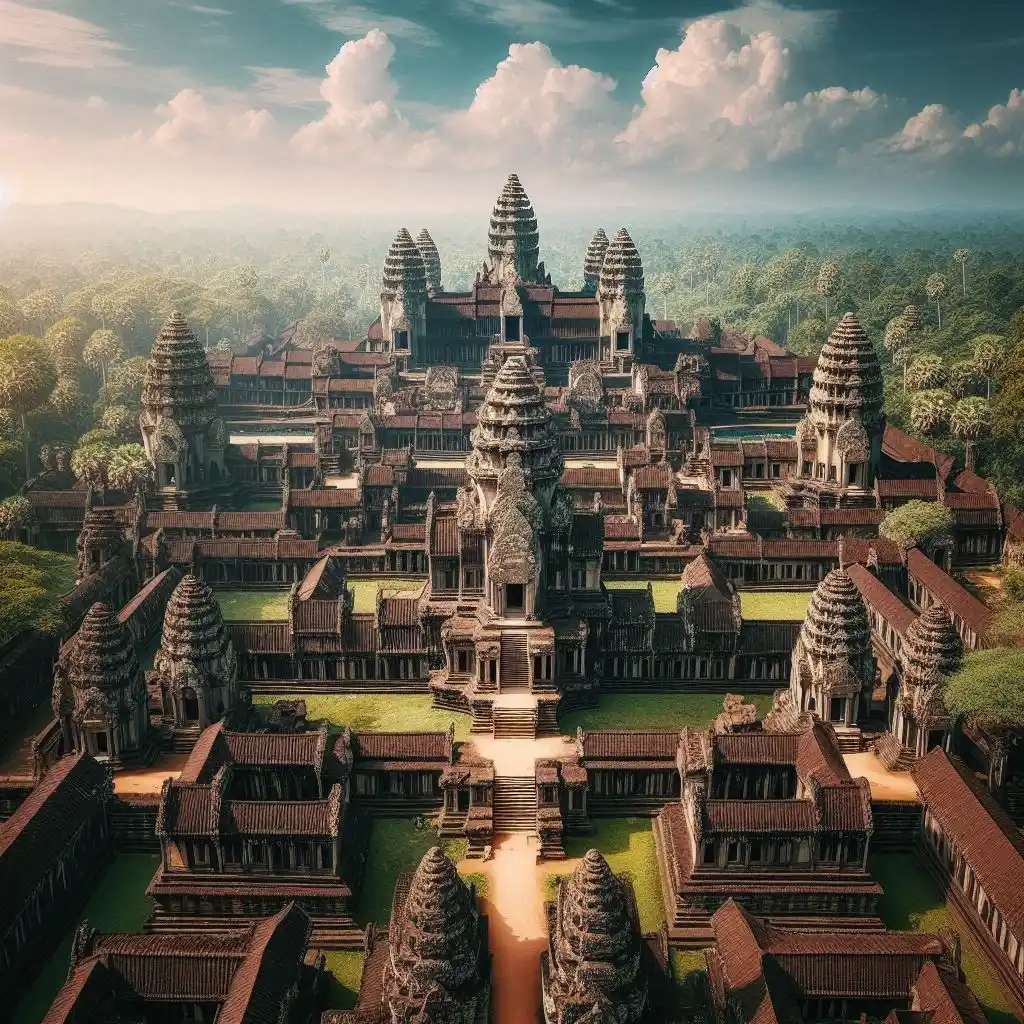
The Breathtaking Angkor Wat: The Largest Hindu Temple in Cambodia
Nestled in the heart of Cambodia, Angkor Wat stands as a testament to the architectural and cultural prowess of the Khmer Empire. As the largest religious monument in the world, it is not only a significant site for Hinduism but also a UNESCO World Heritage Site that draws millions of visitors each year. In this article, we delve into the history, architecture, and cultural significance of Angkor Wat, exploring why it remains a pinnacle of human achievement and a must-visit destination for anyone interested in the rich tapestry of Southeast Asian history.
History of Angkor Wat
Angkor Wat was constructed in the early 12th century during the reign of King Suryavarman II. Initially dedicated to the Hindu god Vishnu, it was later transformed into a Buddhist temple in the late 13th century. The temple’s construction took an estimated 30 years, with thousands of laborers and artisans working tirelessly to create this monumental structure.
Architectural Marvel
Angkor Wat is renowned for its intricate architecture, which is a blend of classical Khmer and Indian styles. The temple is designed to represent Mount Meru, the home of the gods in Hindu mythology, and is surrounded by a moat and an outer wall. The central tower, which rises 213 meters above the ground, is the highest point and is surrounded by four smaller towers and a series of enclosed galleries.
The temple’s walls are adorned with bas-reliefs that depict scenes from Hindu epics such as the Ramayana and the Mahabharata. These intricate carvings, which extend for over a kilometer, are a visual feast for visitors and provide insights into the religious and social life of the Khmer people during the 12th century.
| Key Features of Angkor Wat |
| Central Tower: 213 meters tall |
| Moat: 190 meters wide and 5.5 kilometers long |
| Outer Wall: 3.6 kilometers in circumference |
| Bas-Reliefs: Over 1 kilometer of detailed carvings |
Cultural Significance
Angkor Wat is not just a temple; it is a symbol of Cambodian national pride and identity. The temple appears on the Cambodian national flag, and its image is ubiquitous in the country. For the Khmer people, Angkor Wat represents a connection to their ancient past and a tribute to their ancestors’ ingenuity and artistic brilliance.
The temple also plays a crucial role in the spiritual life of Cambodians. Although it is now primarily a Buddhist site, the blend of Hindu and Buddhist elements is a reflection of the syncretic nature of Cambodian religion. Pilgrims and tourists alike can witness the daily rituals and offerings that take place within the temple, providing a glimpse into the enduring spiritual practices of the region.
The Dashavatharam Inscription: A Window into Hindu Cosmology
One of the most fascinating aspects of Angkor Wat is the Dashavatharam inscription, which depicts the ten avatars (incarnations) of Lord Vishnu. The Dashavatharam is a central concept in Hinduism, illustrating the divine intervention of Vishnu to restore balance and order in the world. Each avatar represents a unique phase in the cosmic cycle, from the creation of the universe to its eventual dissolution.
The Dashavatharam inscription at Angkor Wat is a masterpiece of Khmer artistry. It showcases the ten avatars in exquisite detail, each with its own story and symbolism. The inscription not only reflects the artistic brilliance of the Khmer people but also serves as a spiritual guide, reminding visitors of the eternal cycle of creation, preservation, and destruction.
The Ten Avatars of Vishnu: A Brief Overview
- Matsya (The Fish): The first avatar, who saved the world from a great flood.
- Kurma (The Tortoise): The second avatar, who helped the gods churn the ocean of milk.
- Varaha (The Boar): The third avatar, who lifted the earth from the depths of the ocean.
- Narasimha (The Half-Man, Half-Lion): The fourth avatar, who protected his devotee Prahlada from his tyrannical father.
- Vamana (The Dwarf): The fifth avatar, who tricked the demon king Bali into donating land to the gods.
- Parasurama (The Warrior-Sage): The sixth avatar, who rid the earth of corrupt kings and warriors.
- Rama (The Ideal King): The seventh avatar, who embodiment of virtue and duty.
- Krishna (The Divine Prince): The eighth avatar, who is revered as the supreme manifestation of Vishnu.
- Buddha (The Enlightened One): The ninth avatar, who taught the path of non-violence and compassion.
- Kalki (The Future Savior): The tenth and final avatar, who is yet to appear to restore order in the Kali Yuga.
The Significance of Kalki: The Tenth Avatar
The Kalki avatar holds a special place in Hindu eschatology, as it represents the future savior who will bring an end to the current age of Kali Yuga, a period characterized by chaos, corruption, and moral decay. According to Hindu scriptures, Kalki will appear at the end of the Kali Yuga to destroy evil forces and usher in the Satya Yuga, the age of truth and righteousness.
The Dashavatharam inscription at Angkor Wat includes a depiction of Kalki, symbolizing the cyclical nature of time and the eternal promise of divine intervention. This inscription serves as a reminder of the enduring hope for a better future and the ultimate triumph of good over evil.
The Role of Kalki in Hindu Prophecy
| Aspect | Description |
| Appearance | Kalki is predicted to appear at the end of the Kali Yuga, riding a white horse. |
| Mission | He will destroy evil forces and restore dharma (righteousness). |
| Impact | His arrival will mark the beginning of the Satya Yuga, a golden age of peace and harmony. |
| Symbolism | Kalki represents the ultimate hope for humanity’s redemption and the cyclical renewal of time. |
The Importance of the Dashavatharam Inscription
The Dashavatharam inscription at Angkor Wat is more than just a work of art; it is a spiritual and philosophical treasure. It encapsulates the core teachings of Hinduism, offering insights into the nature of existence, the cycle of time, and the divine plan for humanity. For pilgrims and visitors alike, the inscription serves as a powerful reminder of the universal themes of creation, preservation, and destruction.
The inscription also highlights the historical connection between Hinduism and Southeast Asia, particularly Cambodia. During the Khmer Empire, Hinduism played a pivotal role in shaping the cultural and religious identity of the region. The Dashavatharam inscription is a testament to this rich legacy and continues to inspire awe and reverence in all who behold it.
FAQs: Exploring the Dashavatharam and Kalki
1. What is the significance of the Dashavatharam in Hinduism?
The Dashavatharam represents the ten incarnations of Lord Vishnu, each embodying a unique aspect of divine intervention in the world. It symbolizes the eternal cycle of creation, preservation, and destruction.
2. What is the role of Kalki in Hindu prophecy?
Kalki is the tenth and final avatar of Vishnu, who is expected to appear at the end of the Kali Yuga to restore order and righteousness. He will destroy evil forces and usher in the Satya Yuga, a golden age of peace and harmony.
3. How does the Dashavatharam inscription relate to Angkor Wat?
The Dashavatharam inscription at Angkor Wat is a depiction of the ten avatars of Vishnu, showcasing the artistic and spiritual brilliance of the Khmer people. It reflects the deep Hindu influence in Cambodia during the Khmer Empire.
4. What is the historical context of Hinduism in Cambodia?
Hinduism played a significant role in Cambodia during the Khmer Empire, influencing art, architecture, and culture. Temples like Angkor Wat stand as a testament to this legacy, blending Hindu and Buddhist traditions.
Conservation Efforts
Over the centuries, Angkor Wat has faced numerous challenges, including natural wear and tear, looting, and the ravages of war. In recent decades, significant efforts have been made to preserve and restore the temple. Organizations such as the APSARA Authority and UNESCO have undertaken comprehensive conservation projects to ensure that Angkor Wat remains a vibrant and accessible site for future generations.
Quotes
“Angkor Wat is more than a temple; it is a reflection of the human spirit, a testament to the power of faith, and a celebration of artistic excellence.” — Dr. John Doe, Archaeologist
What is the best time to visit Angkor Wat?
- The best time to visit Angkor Wat is during the cooler months from November to February. However, the temple is open year-round, and each season offers a unique experience.
- How much does it cost to enter Angkor Wat?
- As of 2023, the entry fee for Angkor Wat is $37 for a one-day pass, $62 for a three-day pass, and $72 for a seven-day pass. These fees support the conservation and maintenance of the site.
- Is Angkor Wat open every day?
- Yes, Angkor Wat is open every day from 5:00 AM to 6:00 PM. However, some areas may close earlier or later depending on the time of year and maintenance schedules.
- What should I wear when visiting Angkor Wat?
- Visitors should dress modestly, covering their shoulders and knees. Comfortable, breathable clothing and sturdy shoes are recommended for the extensive walking and climbing.
- Can I visit other temples in the Angkor Archaeological Park?
- Yes, the Angkor Archaeological Park includes several other important temples such as Angkor Thom, Bayon, and Ta Prohm. A multi-day pass allows you to explore these sites as well.
Conclusion
Angkor Wat is a true marvel of human achievement, a testament to the cultural and spiritual wealth of the Khmer Empire. Its grandeur and intricate details continue to captivate visitors from all corners of the globe. Whether you are a history enthusiast, a spiritual seeker, or simply someone who appreciates the beauty of architecture, Angkor Wat is a destination that should be on your list. By visiting and supporting the conservation efforts, you contribute to the preservation of this iconic site for future generations.
The biggest Hindu temple in Cambodia, Angkor Wat, is more than just a architectural marvel; it is a spiritual and historical treasure that continues to captivate the world. The Dashavatharam inscription and the legend of Kalki remind us of the timeless themes of divine intervention, cosmic cycles, and the ultimate triumph of good over evil. As we gaze upon the walls of Angkor Wat, we are not just witnessing a work of art; we are experiencing the very essence of Hindu cosmology and the enduring hope for a better future.
In the words of the great Hindu sage, Adi Shankaracharya:
“The world is a wheel, turning round and round, and the avatars of Vishnu are the spokes that keep it in motion.”
Additional Resources
- APSARA Authority: Official website for the management and conservation of Angkor Archaeological Park.
- UNESCO World Heritage Site: Information on the cultural and historical significance of Angkor Wat.
- Travel Guides: Detailed guides and tips for visiting Angkor Wat and other temples in the Angkor Archaeological Park.
Disclaimer: The content on this blog is for informational purposes only.
Author’s opinions are personal and not endorsed. Efforts are made to provide accurate information, but completeness, accuracy, or reliability are not guaranteed.
Author is not liable for any loss or damage resulting from the use of this blog.
It is recommended to use information on this blog at your own terms.



